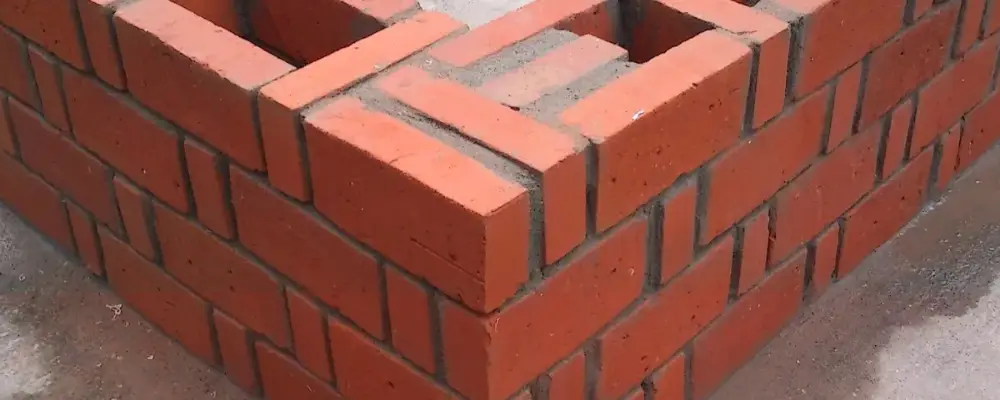A rat trap bonding wall method is used to assemble brick walls. They can almost reduce 30% of the cost and material requirement of the construction work. This method effectively lowers construction costs and material requirements. The cavity created in this brick wall enhances the structure’s thermal efficiency without encompassing its stability. Let us explore detailed information about a rat trap bond wall.
What is Rat Trap Bond Wall?
A rat trap bond is a common mason brickwork that involves placing the bricks vertically rather than horizontally. Unlike conventional wall construction, it creates a gap between the bricks while placing them by keeping the same thickness of the wall. The famous architect Laurie Baker introduced this rat trap bond wall method in Kerala, which reduces construction costs and other material needs.
This type of building brickwork is commonly called a Chinese brick bond, which drastically reduces the number of bricks required for building a wall without compromising the quality of the work.
How to Construct a Rat Trap Bond Wall?
In rat trap bond, bricks are arranged vertically rather than horizontally, meaning that the larger 110 mm face of each brick is visible from the exterior rather than the smaller 75 mm face (assuming the brick size is 230 x 110 x 75 mm). The wall’s overall thickness remains at 230 mm, but a cavity (space) is created inside due to this vertical arrangement.
The first and last layers of the wall are built using a conventional method. To fix any mistakes, the sides and sills are also formed using solid masonry to incorporate any frames. The horizontal and vertical bars are inserted into the cavity to provide additional strength and support to the structure as well as resistance to earthquakes. Electrical work and plumbing can be done with prior planning to put inside the cavity for a better aesthetic look.
Things to Consider While Using Rat Trap Bond
The selection of bricks is a crucial factor in determining the quality of the rat trap bond. As it requires only minimal materials, you have to use first-class quality items in building your walls to get excellent outcomes. Several factors are involved in selecting the right type of brick for rat trap masonry work. They are as follows:
- While choosing the right type of brick, make sure to choose only the standard size of the brick. Even a minor variation in size may create a weakened structure.
- The standard brick size in India typically measures between 200-250 mm in length, 100-115 mm in width, and 65-75 mm in height.
- The corners and edges of the brick should be sharp enough without being blunt to achieve the desired result.
- This modular type of brickwork always needs uniform materials to attain the expected results.
Applications of Rat Trap Bond in Modern Construction
Rat trap bond is frequently utilised in a range of construction projects, such as institutional buildings, commercial buildings, and residential dwellings. Since its thermal insulation qualities help to keep rooms cool during the summer, it is especially well-suited for areas with hot climates.
Rat trap bond is superior to conventional brick bonding techniques like stretcher bond and Flemish bond in several ways. It is a favoured option for resilient and sustainable building projects because of its special design, which offers superior water drainage capabilities, increased structural stability, and higher thermal insulation.
Advantages of Rat Trap Bond
- The empty spaces inside the brick act as thermal insulators to maintain the temperature during summer and winter.
- For constructing a rat trap brick wall, only fewer bricks are used than in the conventional method.
- You can use this brick wall as a partition or a load-bearing wall.
- It is mainly used for giving aesthetic appearance rather than conventional use.
- A perfect choice for draining waters, thus avoiding the formation of mold and mildew growth.
- Structures built using this method serve as examples of long-lasting durability.
Disadvantages of Rat Trap Bond
- Not effective in providing sound insulation.
- Requires mid-level or skilled labourers for undertaking this construction work.
- Frequent cleaning should be done if you have not plastered the wall.
- Effective planning is required to build a rat trap bond wall.
Design Consideration for Rat Trap Bond Wall
The first step for constructing a rat trap bond wall is to make a solid first and last layer without a cavity. Lay the bricks on the edge in a continuous row while maintaining a space of about half an inch between the bricks. The first layer would be four inches high, with the ends of the bricks facing the wall’s inner and outer faces.
The third row from the ground should be two parallel-laid bricks along the interior and exterior surface of the wall with the cavity between them. The ends of the bricks can be balanced by placing a single brick on the edge that spans the width of the wall. A single layer of brick can be laid at the base of the window opening. Reinforcement bars can be inserted inside the cavity to resist earthquakes.
Conclusion
In India, most of the houses in villages or urban areas are constructed in single-story or two-story buildings. To provide effective cost savings to the project, one can incorporate the rat trap method brickwork. As the construction is visually appealing, you may not need plastering on many occasions.
FAQ’s
In the rat trap bond wall method, a hollow space is created by placing the bricks vertically rather than horizontally. This forms a unique design and reduces heavy material usage.
The ultimate purpose of a rat trap bond wall is to provide thermal insulation and reduce extra material requirements.
The quality, shape, and size of the brick should be uniform to get the desired results.

